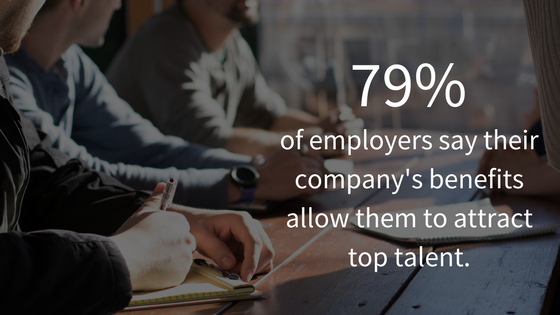I recently got my hands on the latest Aflac WorkForces Report (AWR), and it is chock full of valuable insights about how employees and employers view the benefits offered in today’s market. The full report has great insights on benefits trends and attitudes, but here we’ve highlighted the top points below as it relates to hiring and retaining employee talent, and how the right benefits package can help.
Why you’ll care: Attracting Talent
Everyone competes for talent. But 79 percent of employers who completed this survey say their company’s benefits allow them to attract top talent. Ask yourself – are you offering a competitive enough benefits package that you can say the same? If not, do you think your competitors are in that 79 percent?

And when it comes to negotiating time for that top talent, keep this in mind: 58 percent of employees are at least somewhat likely to take a job with slightly lower pay but better benefits. So, salary, while important, is not your only lever.
Further to this last point, Aflac’s survey shows this number (58 percent) has stayed consistent for five years now, only varying by a percentage point or two each year. Net-net: benefits really matter. How do yours stack up?
Why you’ll care: Retaining Talent
Attracting talent is not your only challenge, we know. Why not retain more of your existing talent?
Because the hard truth is 49 percent of employees are at least somewhat likely to look for new jobs in the next 12 months.
Now you’re thinking “Crap! What if half of my workforce starts sniffing around for available opportunities in the next year? What if those folks leave? How much will I have to spend on recruiting to replace them? On-boarding time to train them?” The short answer: Probably a lot.

Guess what? You can improve the odds they’ll stay
According to Aflac’s survey, 39 perfect of employees say improving their benefits package is one thing their employer could do to keep them in their jobs (second only to ‘increase my salary’).
Turns out that employees want an employer who appreciates them and invests in them enough to offer awesome benefits. Not rocket science right? Seems simple. You probably think your benefits package already stacks up!
Think again. Aflac reports that 42 percent of employees surveyed are only somewhat satisfied with the benefits package offered to them, and nine percent are not very or at all satisfied (51 percent total).
In summary, let’s look at the math:
- Approximately half of your workforce will look at what’s available in the job market in the next year
- Approximately half of your workforce is less-than-thrilled with the benefits package offered (Coincidence? We think not.)
- Improving your benefits package can help retain 39 percent of that half who might go looking (or, approximately 20 percent of your overall workforce)
Now what? How do you know the right benefits to offer?
Let the numbers speak for themselves: 37 percent of employees say reducing debt is what they would do with extra funds (second to 38 percent who said paying monthly bills)
It’s not Taco Tuesdays or a gym membership that are going to make you more competitive, it’s what you can do for the employee to help unbury them the debt they incurred to qualify them to work at your company.
Peanut Butter helps employers offer Student Loan Assistance programs so that you can attract talent faster and retain talent longer. We are experts in benefit administration and make the design, roll-out, and ongoing success of your program easy. For pennies on the dollar you’d otherwise spend replacing employees and hiring new ones, get started today with Student Loan Assistance and become a part of the solution to America’s (and your employees’) student debt problem.
About the study
The survey was conducted with results from 35,000 employees and 13,000 employers across seven years, and across a statistically significant range of industries, company sizes, geographies and demographics. Stats in this post pertain to 2017 results. View the entire study here.